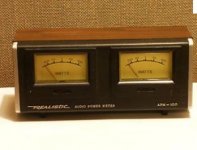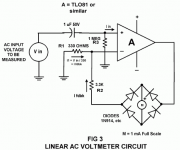I’m getting ready to knock the rust off what little I learned about electronics years ago and build an amp or two. While I’ve found some great ideas here, there is one detail I’d like to add that I’m missing. The analog meters on the front of older amps always intrigued me. I’d like to add them to what I end up building, for mostly aesthetic reasons. My question is, how and where? On the power side of the amp monitoring current flowing into the amp, just before the speaker jacks to measure delivered amps, or volts…or ??? I’d like not to mess with sound quality in any large way. Any thoughts, resources, etc???
My apologies if this has already been answered. I used search and gave up after a while of not finding what I was looking for.
Many thanks,
Jeff
My apologies if this has already been answered. I used search and gave up after a while of not finding what I was looking for.
Many thanks,
Jeff
if You want the meters to somewhat reflect the setting of the volume knob, then You add an opamp after the volume controlls of the amplifier, and make that drive the meters.
otherwise You connect the opamp before the volume knob, and it will reflect the volume of the source.
otherwise You connect the opamp before the volume knob, and it will reflect the volume of the source.
Most meters use a simple passive rectifier and read the "voltage" across the speaker terminals. The meter is calibrated such that this "voltage" equates to "power into 8 ohms". So in practice that means that for 2.83 volts sine wave RMS voltage the meter scale will say 1watt at that point. Yes 
Downsides are that this in no way measures real power. If you disconnect the speakers the meter still reads the same because the voltage at the speaker terminals on the amp is the same.
To measure power properly (and I don't know of any amps that do this) would need to take into account the voltage and current and phase angles that a reactive load like a speaker causes. It can be done but the meter circuit would be more complex than the amp.
Disadvantages of the simple meter circuit are that it can be insensitive and being passive there is the volt drop of the diodes to overcome. Germanium can be best here or you can use a simple opamp based rectifier to eliminate the diode drop completely.
Best thing you can do is look up some old manuals of amps (and cassete decks with VU meters becaus ethey are essentially the same and just measure voltage) and see how they are configured.
The loading od such circuits is negligable on any amp and won't alter the sound in any way at all.
Downsides are that this in no way measures real power. If you disconnect the speakers the meter still reads the same because the voltage at the speaker terminals on the amp is the same.
To measure power properly (and I don't know of any amps that do this) would need to take into account the voltage and current and phase angles that a reactive load like a speaker causes. It can be done but the meter circuit would be more complex than the amp.
Disadvantages of the simple meter circuit are that it can be insensitive and being passive there is the volt drop of the diodes to overcome. Germanium can be best here or you can use a simple opamp based rectifier to eliminate the diode drop completely.
Best thing you can do is look up some old manuals of amps (and cassete decks with VU meters becaus ethey are essentially the same and just measure voltage) and see how they are configured.
The loading od such circuits is negligable on any amp and won't alter the sound in any way at all.
Real VU meters are either relatively complex, relatively expensive, or (most likely) both. Rod Elliott has an alternative circuit as ESP Project 55 that should satisfy.
Just label them with Vac instead of WMost meters use a simple passive rectifier and read the "voltage" across the speaker terminals. The meter is calibrated such that this "voltage" equates to "power into 8 ohms". So in practice that means that for 2.83 volts sine wave RMS voltage the meter scale will say 1watt at that point.
I would rather know I had maximums around 1V or 5V or 25V, than some power figure that is meaningless.
But, there again I would probably use a dB scale, starting at +1dB = maximum sinewave voltage into a 50r test load.
Then work down from there to maybe -30dB for the lowest green LED.
Just label them with Vac instead of W
I would rather know I had maximums around 1V or 5V or 25V, than some power figure that is meaningless.
But, there again I would probably use a dB scale, starting at +1dB = maximum sinewave voltage into a 50r test load.
Then work down from there to maybe -30dB for the lowest green LED.
Or we can be safe in the knowledge of our designs and use a term coined by Rolls Royce,
Power output is 'undisclosed' but 'entirely sufficient'.
I think meters are more eye candy than anything else... and having said that my amp has them as you know and yet in practice they never move off the end stops for 95% of my listening (that's the lower end if you are wondering
They are scaled in watts and calibrated to the "volts into 8 ohm" standard. These were originally a Tandy (Radio Shack) free standing meter assembly that I got as a youngster and always held onto. Seemed an ideal use for them after all these years. I added LED backlighting which doesn't look brilliant in the photo but is very soft and even in reality.
Post #380
http://www.diyaudio.com/forums/mult...wer-do-your-speakers-need-19.html#post2893167
Ebay has some unbelievably...
Post #380
http://www.diyaudio.com/forums/mult...wer-do-your-speakers-need-19.html#post2893167
Ebay has some unbelievably...
Attachments
Eye candy is all I need for this one. Thanks for the info. 
Or we can be safe in the knowledge of our designs and use a term coined by Rolls Royce,
Power output is 'undisclosed' but 'entirely sufficient'.
I think meters are more eye candy than anything else... and having said that my amp has them as you know and yet in practice they never move off the end stops for 95% of my listening (that's the lower end if you are wondering)
I think something simple like this would follow the signal strength and provide the aesthetic sweetness. Just change the bridge to a single-diode halfwave in series with the meter, and modify component values for your app.
This from the R. Graf & W. Sheets op amp article at their North Country Radio website:
This from the R. Graf & W. Sheets op amp article at their North Country Radio website:
Attachments
Hi,
Without "peak hold" a volts into 8ohms meter is pretty useless for music.
Peak hold is the only useful meter indicator for amplifiers, though a nice
addition is flashing LED that genuinely flashes with > 1% to 3% distortion,
(by genuinely comparing the input to output so loading issues are included).
Even with peak hold it needs to be in dB to not spend most of the time
doing nothing interesting, even "eye candy" has to properly designed
to do what you want it to.
rgds, sreten.
Without "peak hold" a volts into 8ohms meter is pretty useless for music.
Peak hold is the only useful meter indicator for amplifiers, though a nice
addition is flashing LED that genuinely flashes with > 1% to 3% distortion,
(by genuinely comparing the input to output so loading issues are included).
Even with peak hold it needs to be in dB to not spend most of the time
doing nothing interesting, even "eye candy" has to properly designed
to do what you want it to.
rgds, sreten.
For wattage, couldn't you use one of those calibrated "current sense" resistors you can get (very low ohms, it would hardly affect the output) and an output voltage sense, both through rectifiers and smoothing,
Then multiply them with an analog multiplier chip (AD534) or make a multiplier with op amps, when the current lags behind the voltage, that would not need to be calculated since it is measuring them both separately.
it would be fairly cheap to make, but probably take quite a bit of time to design. maybe too much work for a chip amp.
Then multiply them with an analog multiplier chip (AD534) or make a multiplier with op amps, when the current lags behind the voltage, that would not need to be calculated since it is measuring them both separately.
it would be fairly cheap to make, but probably take quite a bit of time to design. maybe too much work for a chip amp.
I was in a hurry and wasn't thinking... no changes are needed to the rectifier. d'oh! (Though halfwave vs fullwave response differences may be interesting.)
The OP has written "aesthetic" and "eye candy" several times already. He can correct me if he needs more than just a meter movement in sync with the audio output.
The OP has written "aesthetic" and "eye candy" several times already. He can correct me if he needs more than just a meter movement in sync with the audio output.
Last edited:
- Status
- This old topic is closed. If you want to reopen this topic, contact a moderator using the "Report Post" button.
- Home
- Amplifiers
- Chip Amps
- meters on chipamps

